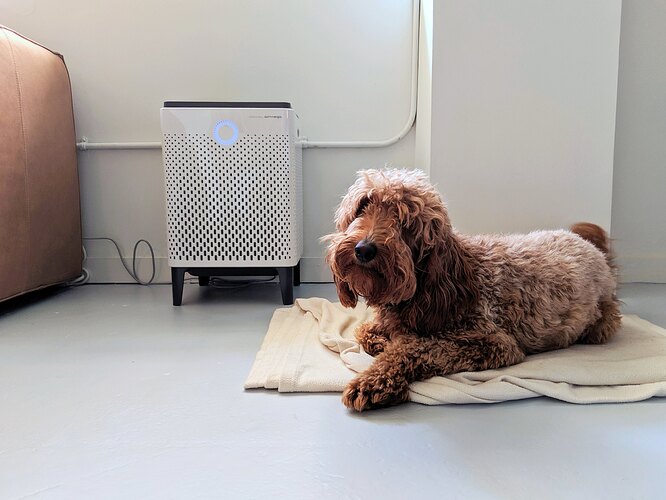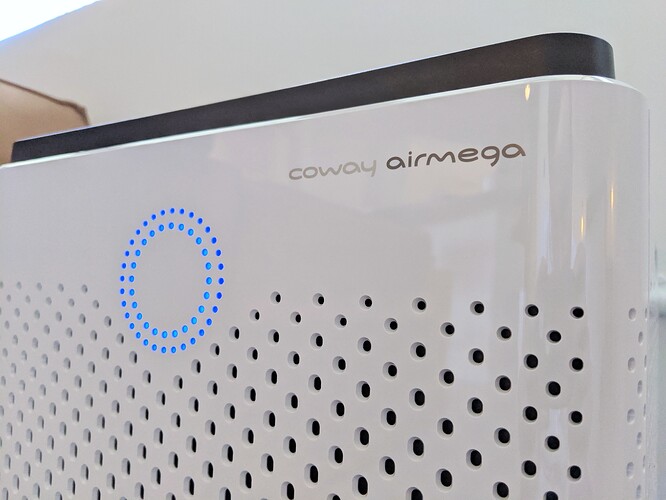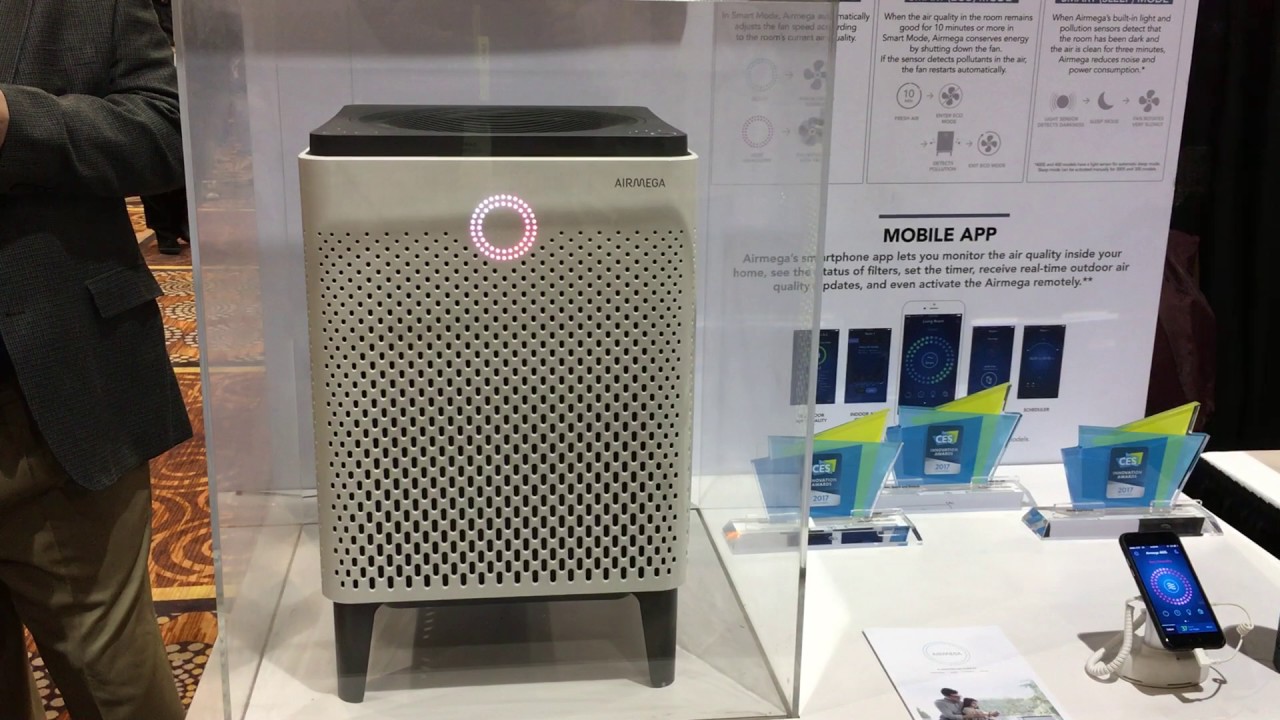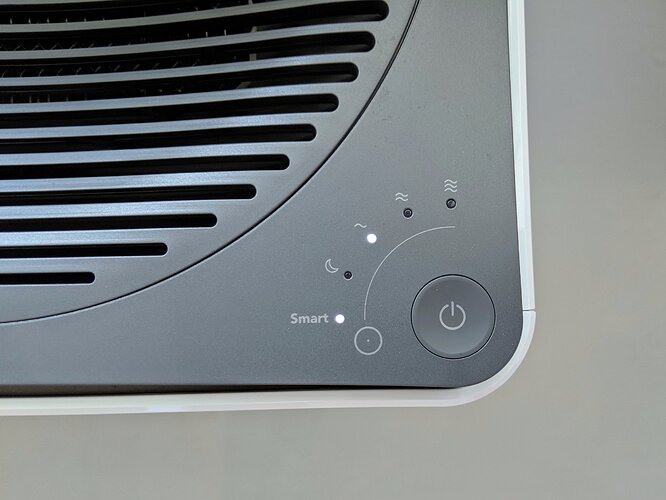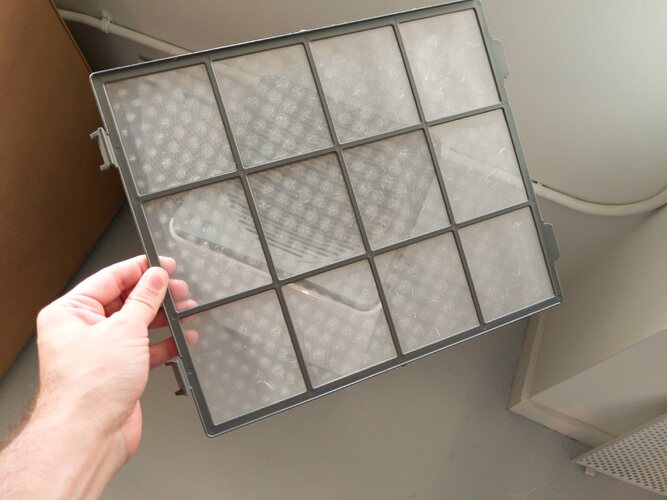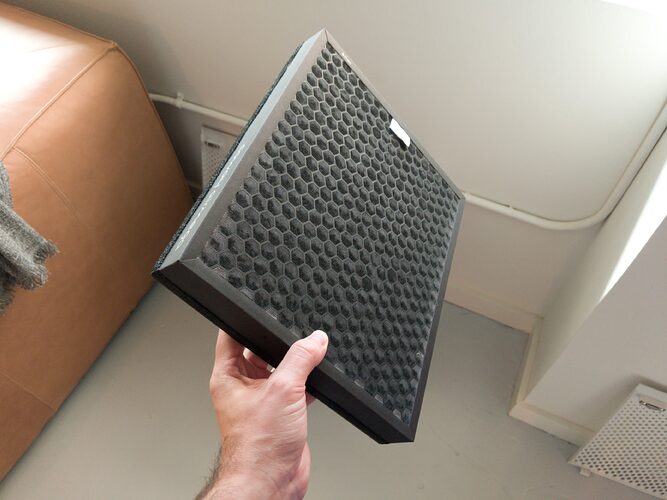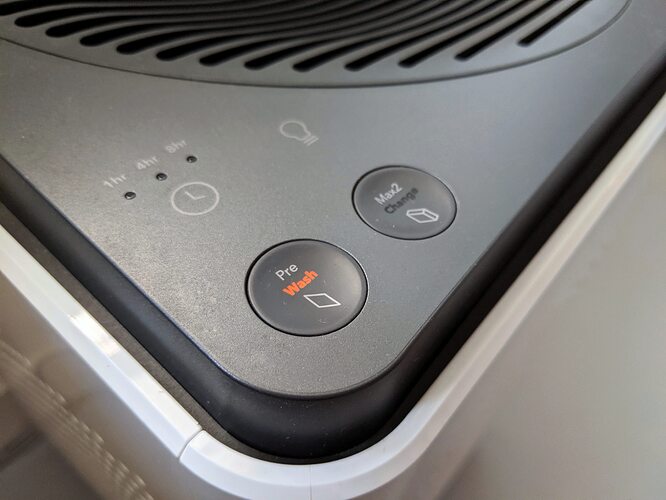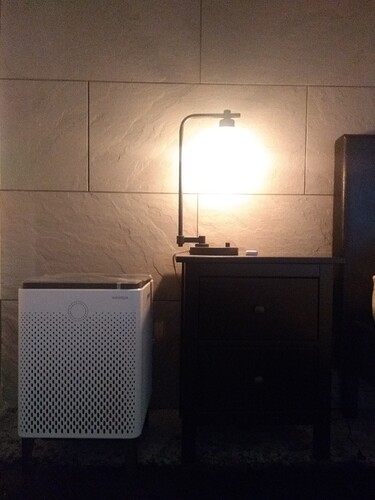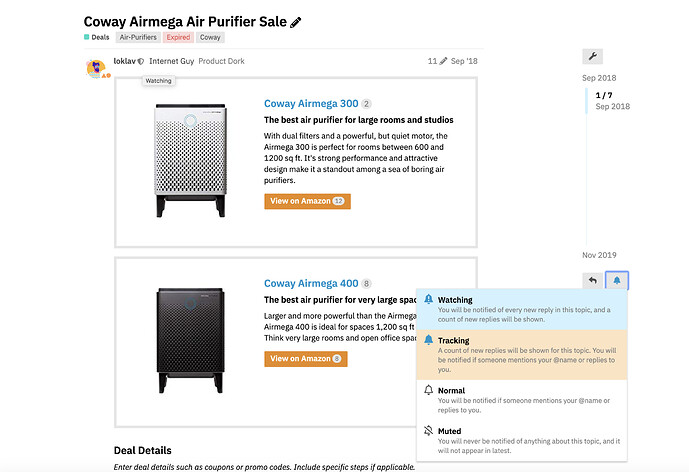If you’re looking to purify several smaller rooms, consider picking up a few Airmega 200Ms instead. You’ll get the same quality, but with better coverage.
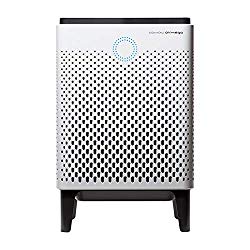
![]()
Coway Airmega 300
The best air purifier for large rooms and studios
With dual filters and a powerful, but quiet motor, the Airmega 300 is perfect for rooms between 600 and 1200 sq ft. It's strong performance and attractive design make it a standout among a sea of boring air purifiers.Table of Contents
- My background
- What does an air purifier do?
- What I like about the Airmega
- Potential issues
- Airmega filter replacement and maintenance
- Comparing the Airmega 300 vs 400
- What about the 300S and 400S smarter air purifiers?
- Airmega vs Molekule
- Airmega vs Blueair
- Final thoughts
- Long-term notes
- Related topics
- References
My background
I’m a product nerd that happens to also have allergies—particularly in the Spring. I spent an extensive amount of time researching to find the best air purifier for my large studio apartment.
In September 2018 I purchased the Airmega 400, not realizing how large it was. I exchanged it for the Airmega 300 and have been keeping long-term test notes since then.
What does an air purifier do?
Indoor air can be several times more dirty than the air outside. There are various sources of indoor air pollution. Smoke from cooking, cleaning cleaning materials and dust from carpets and furniture are large contributors. If you have dogs or cats, pet dander can contribute to the problem significantly.
Air purifiers greatly reduce many of these indoor particulates by using fans to force air through a filter. HEPA stands for High Efficiency Particulate Air. HEPA filters are found in most air purifiers and catch 99.97 percent of particles whose diameter is greater than or equal to 0.3 µm. Those are exceptionally small particles. This works particularly well for those with allergies, asthma and other respiratory problems.
This is covered in-depth with the EPA’s Guide to Indoor Air Quality.
In the last several years, a growing body of scientific evidence has indicated that the air within homes and other buildings can be more seriously polluted than the outdoor air in even the largest and most industrialized cities. Other research indicates that people spend approximately 90 percent of their time indoors. Thus, for many people, the risks to health may be greater due to exposure to air pollution indoors than outdoors.
Because all HEPA filters are held to the same standard, the defining metric of an air purifier is air changes per hour. ACH determines the number times a purifier can completely change the air in a room.
You might see this metric appear as Coverage or Maximum Coverage. If an air purifier says it has 1,256 sq ft of coverage, like Coway’s Airmega 300, that means that the purifier is capable of changing all the air in the room two times every hour.
While 2 ACH is fine for most those with bad allergies, you may want closer to 4 ACH. To get there simply half that maximum coverage number. With the Airmega 300, you’ll get 4 ACH in a 628 sq ft room.
One additional thing to note. HEPA filters will not eliminate odors or volatile organic compounds—known as VOCs. If you need to do that, you should consider an air purifier like the Austin Air HealthMate. It has both a HEPA and an activated-carbon filter.
What I like about the Airmega
There’s a lot to like about the Airmega 300. It’s powerful, attractive, quiet and smart.
Power and coverage
Power is the defining feature of Airmega air purifiers. If you need to purify a large room, then you want an Airmega. If you don’t believe me, hit play on the video below.
It was this video of the Airmega at CES that convinced me that it was the air purifier I needed. The Airmega 300 has dual suction, drawing air in from both sides. That makes it perfect for large rooms and studios—anything up to 1,256 sq ft. At that size it will filter all the air in the room twice in one hour (2 ACH).
If you live in the western U.S. and want an air purifier to deal with wildfire smoke, then the video should be convincing. It’s excellent and removing smoke from rooms.
If there’s one reason to buy the Airmega 300 over other air purifiers, I’d say that Smart Mode is it.
Attractiveness
Attractiveness is an underrated attribute for most air purifiers. Those with a lot of coverage tend to be fairly large and because of the air intake they can’t be stuffed between things. This means that they have to stand on their own, out in the open.
The Airmega is an attractive purifier. It’s obvious that Coway payed attention to the details. The LED indicator light, the braided power cord. The white and black contrast. It’s attractive.
It’s surprising to me that there are so many ugly air purifiers. Just take a quick look at some of these: Germ Guardian, Sharp Plasmacluster or this air purifier from Rowenta. If you aren’t going to invest in design, at least create a neutral-looking device—something like the Austin Air Healthmate.
Quiet fans
The Airmega is exceptionally quiet. On low the fans are inaudible at about 22dB. The only time I notice the fans are when I’m searing something on my stovetop. Even then it gets up to about 52dB, which is fairly quiet. It won’t interfere with you listening to music or the TV.
The primary reason the Airmega is so quiet is it’s low fan speed. As mentioned elsewhere in this review the Airmega is a large device, which allows bigger fans. Bigger fans are quieter as they can move the same amount of air as smaller fans without spinning as fast.
The other thing that keeps the fan speed low is a dual-fan design. Because the Airmega has two fans and two filters, each fan can work less to filter the same amount of air. It’s a clever design.
If you’re sensitive to noise and need an air purifier, the Airmega 300 is an excellent choice.
Smart Mode is just smart enough
As some of you regulars know, I’m skeptical of any appliance that’s smart. That’s not the case with the Airmega air purifiers though. Their intelligence is limited to having a built-in air quality monitor, which determines fan speed. I think this is genius. Here’s what the manual says about the Airmega Smart Mode and Eco Mode.
If the pollution level remains Good for more than 10 minutes when the product is set to Smart mode, the fan stops automatically to conserve energy. If the product detects air pollution, the fan will automatically restart.
This takes a powerful—and power-hungry—device and makes it incredibly efficient. I keep my Airmega in Smart Mode almost all the time. Usually, it’s either on low or off. However, a few minutes after I start cooking—especially if I’m pan frying a steak—the air quality indicator turns red and fans kick into high gear.
The indicator has a few different levels that correspond to fan speed.
- Blue - Excellent air quality, Airmega fan in Eco Mode
- Purple - Moderate air quality, Airmega fan on low
- Pink - Poor air quality, Airmega fan on medium
- Red - Very poor air quality, Airmega fan on high
Potential issues
The LED air quality indicator light is pretty bright. In my old apartment I ended up turning it off. If you’re trying to sleep, it’s outrageously bright in a dark room. My new apartment is pretty bright at night, so I don’t notice it. I believe the Airmega 400 and both of the S models have a built-in light sensor that turn the indicator light off at night.
Also notable—after about eight months of use I noticed that the LED air quality indicator had stopped coming on. The Airmega had a power issue. I’m pretty sure this was related to a power issue in my place. As I had to replace a $400 circuit board in my refrigerator at about the same time.
The good news is the exchange process was pretty easy. I wrote a bit about the problem in another topic. I received the replacement in a few days, which was surprisingly fast.
I do belive this was caused by a power surge. However, if anyone reading this has a defective Airmega, please leave a comment. I’d love to know about it.
Airmega filter replacement and maintenance
The Airmega 300 is fairly low maintenance. However, there are a couple of things that Coway recommends to keep your Airmega in top shape.
The most common task is cleaning and replacing the mesh pre-filters. I’ve found they need to be cleaned every month or two. It’s pretty easy, just rinse them off under the sink and then wipe them down with a paper towel. Then they sit for an hour or two until they are completely dry.
You’ll need to order a Max 2 filter replacement once a year. These are the larger HEPA filters that do the majority of the cleaning.
Both filter types have indicator lights that signal a replacement or cleaning is needed. So there’s no need to put upgrade times on your calendar.
The dust sensor is another important component of the Airmega that needs a bit of cleaning. You’ll need to remove the front plate and open the dust sensor—it’s the little door in the middle of the air purifier.
If you want more information about to do this, refer to page 29 of the Airmega User Manual. There’s a ton of helpful illustrations.
Coway recommends doing this every two months, but I’m not sure you need to be so prompt. I’ve probably done it once every six months. Unless you feel the sensor isn’t responding well-enough, I’d say every six months is plenty.
The last thing is less prescriptive. Just take a microfiber cloth and wipe it down every now and then. The thing is constantly pulling in dust and soot. It is bound to collect in on the outside. While you’re at it, open the top vent and give it a wipe.
Comparing the Airmega 300 vs 400
I’ve committed a full post comparing the Airmega 300 against the Airmega 400. If you’re sold on Airmega, but are trying to decide if you should get the 300 or 400, it’s a worthwhile read. There are a few primary differences though: size, coverage and cost.
Size and Power—the Airmega 400 is both larger and more powerful than the 300. It’s at least an inch larger in every direction. You might not think that’s a lot, but the 400 is about as large as a nightstand. Here’s a picture of it next to my IKEA Hemnes nightstand.
Because of it’s size and additional yearly costs, I decided to exchange the 400 for the 300 model.
The 400 provides more square feet of coverage than the 300. If the space is truly large—perhaps an open office or large room in a house—then the 400 is the way to go. However, I think the 300 will be more than adequate for most people.
The 400 costs more than the 300. You’re bound to spend more upfront, but you’re likely to spend more on power and filter replacements. If you’re looking at annual filter replacement costs, the 400 will cost you about $40 more than the 300.
There are some other things such as available colors and included sensors, but I don’t think those are as important.
| Specifications | Airmega 300 | Airmega 400 |
|---|---|---|
| Price Range | $350-$650 | $500-$750 |
| Dimensions WxHxD | 13.6 x 21.2 x 13.6in | 14.8 x 22.8 x 14.8in |
| Weight | 21.4 lb | 24.7 pounds |
| Purifying Coverage (2 ACH) | 1,256 sq ft | 1,560 sq ft |
| Purifying Coverage (4 ACH) | 628 sq ft | 780 sq ft |
| Annual filter cost | ~$80 | ~$120 |
| Noise Level | 22~52 dB | 22~52 dB |
| Power usage | 57 W | 66 W |
| Sensors | Dust / Pollution | Dust / Pollution / Light |
| Available Colors | White | White or Graphite |
If there’s a spec missing here, let me know in the comments. I’ll update this table.
What about the 300S and 400S smarter air purifiers?
You’ve probably seen a few models that have an “S” after them. These are the Airmega 300S and 400S.
The primary difference here is that these models are WiFi integrated and connect to Coway’s app. In my opinion the base models are smart enough. SlashGear’s 400S review covers Coway’s app in a good bit more detail. If you’re considering a 300 vs the 300S, it’s a worth a read.
The “S” version of the 400 Series – as with the 300 Series – is the smart model. That means it has WiFi integrated, and works with Coway’s app. Unfortunately that’s a little underwhelming.
The one redeeming quality of the smart models is the ability to control multiple Airmega air purifiers at once. I actually think this is a great feature for offices. I could easily see a startup or company with an open offices purchasing a few Airmega 400S units. Being able to link them all to a single app would be fantastic.
As for larger homes I think it’s less useful. Rooms will have different pollution levels. It makes more sense to purchase a regular model and let Smart Mode work for each room.
There are some less important details. The filter replacement indicators show progress towards replacement. I’m also a bit of a sucker for the 2-tone LED indicator light. It’s a nice touch.
There’s no harm, if you can pick up the 300S or 400S at the same price or lower. However, I think most people are better off with the base models.
Airmega vs Molekule
The Molekule is not in the same price range or performance category as the Airmega. However, questions about it have appeared on Product Dork before, so I thought it was worth adding a section comparing the Airmega to Molekule.
| Specifications | Airmega 300 | Molekule |
|---|---|---|
| Price Range | $350-$650 | $799 |
| Dimensions WxHxD | 13.6 x 21.2 x 13.6in | 8.25 x 23 x 8.25in |
| Weight | 21.4 lbs | 18 lbs |
| Purifying Coverage (2 ACH) | 1,256 sq ft | 300 sq ft |
| Purifying Coverage (4 ACH) | 628 sq ft | 150 sq ft |
| Annual filter cost | ~$80 | ~$130 |
| Noise Level | 22~52 dB | 32~55 dB |
| Power usage | 57 W | 20-85 W |
The Molekule is expensive. At $799 the air purifier is about twice as expensive as the Airmega 300. Additionally, the filter needs to be replaced twice a year at a cost of $135.
Part of that cost is associated with new technology. Coway’s Airmega uses a fan with traditional HEPA filters. It doesn’t have an activated-charcoal filter or any way to remove VOCs from the room. Molekule uses a new technology called Photo Electrochemical Oxidation (PECO) to remove dust as well as VOCs. This PECO process is described in SAGE Journal.
Photoelectrochemical oxidation (PECO) is a revolutionary new technology for providing an air purification solution. In addition to physical filtration, a photoelectrochemical reaction takes place on the surface of a nano-coated filter leading to the oxidation of organic matter. These processes allow for the destruction of organic material 1000 times smaller than what a HEPA filter can capture. Thus, PECO not only removes but can also efficiently destroy organic matter, bacteria, viruses, mold, and VOCs converting them into their trace elements.
There are also some doubts about the Molekule technology. In a previous discussion I mentioned some dissenting opinions I had found on forums I had visited.
Molekule would not allow The Wirecutter to review the air purifier unsupervised.
We requested a model because we were interested in testing its effectiveness on micron-scale particulates and VOC reduction, but Molekule requested that we agree to conditions around the testing—asking that a Molekule engineer or a consulting researcher they’d worked with in the past monitor and advise on our work if we conducted testing on our own.
I discovered a few threads on reddit that had some concerning comments about the product. In a thread asking owners about their experience with Molekule, I found these comments.
u/specikk:
The first thing that struck me as odd was that the Molekule contains no sensor to monitor air quality-- at least not ones that are exposed to the app or used by the device itself. Perhaps they are in the hardware and will be enabled by a software update? It seems like quite an oversight to not include a basic air quality sensor for a device at this price point.
u/sAfuRos:
I had a lot of back and forth’s with Molekule CS as an original Molekule pre-backer over a year ago because the filters reek and continue to do so.
Molekule says this is due to “contaminants that may enter the filter during the packaging and transit process” but that sounds like BS to me. I had no less than 5 filters sent to me total (for free, so props to molekule CS for that) and they all had the horrible smell. The smell goes away over time but never fully leaves, such that in a small room the smell will permeate the entire room even months after the same filter has been running 24/7.
After my own research, I believe this is due to the fact that it’s very difficult to bond TiO2 molekules (which is what Molekule is using on the nanofilter) as a coating; you’ll almost certainly get offgassing for the entire life of the filter, as small nano-particles essentially ‘fall-off’. I believe this lines up very strongly with the evidence that others have posted about VO2 levels not decreasing or even increasing; the decrease in other Vo2 compounds is offset by the Molekule’s own offgassing.
There was also a thread about air purifiers on Hacker News. This comment from a previous Molekule owner stuck out to me.
I had one. It has multiple issues:
- CADR is really low to the point where the unit is near useless due to #2
- In addition to a low CADR, it has the highest noise. It looks and sounds like a jet engine when you have this thing on high, which is needed due to the low CADR. This is the loudest air purifier that I’ve ever owned
- If you get a defective main filter, the unit will emit an unpleasant metallic smell. I haven’t tested the particles yet but I doubt the air is clean.
- Unlike other smart air cleaners in the same price range, it’s app and smart features don’t work. You can’t even create a schedule for it
It’s a very flawed device
Maybe Molekule’s team will fix these problems in the future. However, I wouldn’t consider purchasing one right now.
Airmega vs Blueair
This year The Wirecutter introduced the Blueair Pure 211+ to its list of best air purifiers. They mostly compared it to the Coway Mighty. However, in size and power it is very similar to the Airmega 300.
| Specifications | Airmega 300 | Blueair Pure 211+ |
|---|---|---|
| Price Range | $350-$650 | $200-300 |
| Dimensions WxHxD | 13.6 x 21.2 x 13.6in | 13 x 21 x 13in |
| Weight | 21.4 lbs | 13 lbs |
| Purifying Coverage | 628 sq ft (4 ACH) | 540 sq ft (5 ACH) |
| Annual filter cost | ~$80 | ~$120 |
| Noise Level | 22~52 dB | 31~56 dB |
| Power usage | 57 W | 31-61 W |
The real mark against the Blueair is the lack of an internal air quality monitor. Perhaps the best feature of the Airmega 300 is the smart setting that adjusts the fan speed based on the air quality in the room.
Other than that, it comes down to price. You’re going to pay at least $50 more upfront for the Airmega. It’s a more expensive device. However, the yearly filter replacement costs for the Blueair are $40 more.
All-in-all it’s nice to see another attractive air purifier at a reasonable price. I particularly like the customizable aspects of the Blueair air purifiers. They all have a washable fabric pre-filter that can be customized. It comes in 5 different colors depending on how colorful you’d like your air purifier to be.
However, I still think the Airmega 300 is a better choice than the Blueair 211+.
Final thoughts
The Coway Airmega 300, with its dual filters and smart sensing technology is the best air purifier for large rooms and big studio apartments. The Airmega’s Max 2 Filter replacements cost about $80 per year. I’ve owned the air purifier since September of 2018 and have spent many hours reading reviews and comparing it with other air purifiers. It’s an attractive device in a category of drab-looking products, but it’s also exceptionally powerful.

![]()
Coway Airmega 300
The best air purifier for large rooms and studios
With dual filters and a powerful, but quiet motor, the Airmega 300 is perfect for rooms between 600 and 1200 sq ft. It's strong performance and attractive design make it a standout among a sea of boring air purifiers.Long-term notes
Purchased an Airmega 400 in September 2018 and later exchanged it for the smaller Airmega 300. Since a products flaws can appear after months or years of use, I publish my long-term notes here. That way you can determine how buy-it-for-life the product is.
-
February 5, 2021 A few years in the Airmega 300 is still a powerful and reliable air purifier. We’ve spent significantly more time at home because of COVID. Having a good air purifier has made a significant difference.
-
July 2, 2020 I’ve ordered a replacement Max 2 filter. The indicator light finally came on. I had been a little worried that it was broken. The HEPA filters are supposed to be replaced annually. It appears these lasted almost twice that. I suppose the replacement indicator is based on usage and not on a timer. I’d say this is a big win for consumers and just another reason to trust Coway.
-
August 12, 2019 This Airmega 300 review is published. I am still very pleased with the air purifier. It has just enough “smarts” to be effective.
-
March 29, 2019 My replacement air purifier arrived. Fast shipping, no issues.
-
March 26, 2019 The Airmega 300 has a power issue that I believe was caused my an electrical surge in my place. I had to fill out Coway’s warranty registration form and they sent me a shipping label. I did have to pay $15 for a box to put the old device in.
-
November 4, 2018 I publish an article comparing the Airmega 300 and Airmega 400.
-
September 4, 2018 I ordered the Airmega 400 and realized that it was much larger than expected. I exchanged it for the slighyly smaller Airmega 300.
Related topics
References
Show References
-
The Inside Story: A Guide to Indoor Air Quality, U.S. Environmental Protection Agency, Retrieved 8/11/2019
-
Don’t Spend Money on an Air Purifier You May Not Need, Consumer Reports, Published 7/3/2018
-
The Best Air Purifier, The Wirecutter, Last Updated 4/26/2019
-
How to Get Better Indoor Air Quality, The Wirecutter, Last Updated 5/1/2019
-
Coway Airmega 400S Air Purifier Review: Less smoke, more smart, SlashGear, Last Updated 11/19/2018
-
Replacing the Airmega Max 2 Filter, Coway, Retrieved, 8/11/2019
-
Airmega User Manual, Coway, Retrieved 8/11/2019
-
Effect of a Novel Photoelectrochemical Oxidation Air Purifier on Nasal and Ocular Allergy Symptoms, SAGE Journals, Published 7/21/2018
-
chaostheory, Build a do-it-yourself home air purifier for about $25, Hacker News, Retrieved 8/12/2019
-
sAfuRos and specikk, What has your experience been with Molekule?, reddit, Retrieved 8/12/2019
-
Steven Tata and Max Mutter, Blueair Pure 211 Review, TechGearLab, Retrieved 8/14/2019
-
Michael Avid, How To Protect Your Breathing Indoors – Blueair Blue Pure 211+ & 411 Air Purifier Review, HighTechDad, Published 10/17/2017
-
Comparative Example of Noise Levels, IAC Acoustics, Retrieved 8/16/2019
-
What’s the best home air purifier to capture PM2.5?, Quora, Retrieved 8/20/2019
-
Rachel Rothman, Do Air Purifiers Actually Work?, Good Housekeeping, Published 7/14/2019
